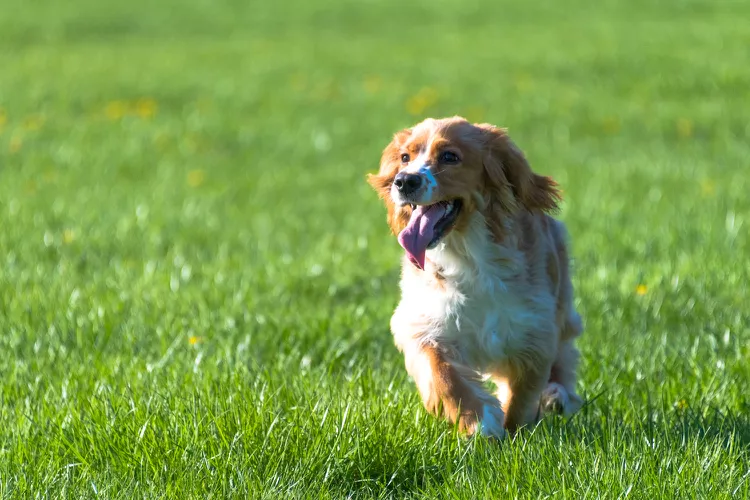Patellar Luxation in Dogs

Patellar luxation is a common problem, especially in small dogs, that can cause issues like cartilage damage, inflammation, pain, and even ligament tears. Recognizing the signs of patellar luxation and seeking treatment can help prevent further damage to your dog's knees and help it live a happy, active life.
What Is Patellar Luxation?
Patellar luxation refers to a condition in which a dog's knee cap (patella) slips out of the groove it's designed to stay in. The femur, which is the large upper leg bone, has a groove down the middle in which the knee cap and its associated ligaments sit. With patellar luxation, the knee cap pops out of this groove in the leg bone, often because the groove is shallower than it should be. This problem can be evident in puppies as young as eight weeks old.
Sometimes, the patella will slip out and then back into the groove; in other cases, it will stay out. Luxations can occur either medially (towards the inside of the knee) or laterally (towards the outside of the knee) and in one or both legs.
Symptoms of Patellar Luxation in Dogs
A dog with patellar luxation will often hold up the affected hind leg when walking. This may occur for a few strides after which they use the leg normally. Other symptoms include:
A dog can have an unusually mobile patella without obvious signs of pain if luxation began recently or the dog is very young. Signs of pain—limping and incessant licking—tend to appear after the condition has progressed for months or years and caused damage to surrounding tissues.
Patellar luxation may be observed in very young puppies, but sometimes it is not apparent until later in life,
What Causes Patellar Luxation in Dogs?
There are two causes of patellar luxation, either of which can become symptomatic at any point in a dog's life, depending upon severity: Congenital anatomical defect is the most common cause. It can also be caused by trauma, like a car collision or a fall.
How Do Vets Diagnose Patellar Luxation in Dogs?
If you suspect patellar luxation in your dog, your veterinarian will conduct a physical exam and x-rays to confirm the diagnosis.
The Orthopedic Foundation for Animals (OFA) has established a grading system for patellar luxation to describe the stage and severity of the condition, as follows, that your veterinary surgeon will use to develop a treatment plan:
- Grade 1: The patella can be moved out of the groove but easily pops back by itself. This is especially common in small breeds like Yorkshire terriers, Chinese crested, and Pomeranians.
- Grade 2: The patella moves out of the groove frequently and may cause the dog to hold the affected leg up on occasion but it can be easily moved back to the correct location and the dog still often walks on it. Because the patella slips in and out of the groove so often, trauma in the knee can occur over time.
- Grade 3: The patella is out of the knee groove most of the time and the tibia, one of the lower leg bones, is moderately twisted. The groove where the patella should sit is very shallow. Some dogs may continue to use the leg but in an abnormal position.
- Grade 4: The patella is permanently out of the knee groove, and the tibia is severely twisted. The groove where the patella should sit is non-existent or even convex instead of concave. The dog will usually hold the leg up.
How to Treat Patellar Luxation
Depending on the severity of the patellar luxation, your veterinarian may recommend that surgery be performed to hold the patella in its appropriate location. Several different surgical procedures can accomplish this with the best option depending on the specifics of the dog's case.
Since knee surgeries are major procedures, veterinarians may advise a wait-and-see approach for a grade one or even a mild grade two patellar luxation. If a dog with patellar luxation is showing signs of pain, has developed the luxation due to knee trauma, or has difficulty walking, then surgery will likely be required to correct the problem. In the most severe scenarios, amputation may be the only option, but this is a rare necessity.
While surgery is, ultimately, the only way to correct a patellar luxation, you can support your dog's knee health through the use of joint supplements. Supplements can help the cartilage stay healthy and decrease inflammation in the joints. Pain relief and other treatments may also be necessary.
Prognosis for Dogs with Patellar Luxation
Low-grade luxations may not require surgery immediately but will likely deteriorate to the point of surgical necessity in the future. Surgery is usually a very successful treatment and helps dogs return to—or attain—an active lifestyle.
How to Prevent Patellar Luxation
Other than doing what you can to prevent a major trauma from occurring, the only way to prevent owning a dog with patellar luxation is to consult the OFA when seeking a breeder. The OFA maintains a database of dogs that have been certified to be free of patellar luxation.